Sleep Cycles
Introduction
Although we lose consciousness as we sleep, the brain nevertheless remains active. The patterns of sleep have been tracked in thousands of research participants who have spent nights sleeping in research labs while their brain waves were recorded by monitors, such as an electroencephalogram, or EEG.
Sleep researchers have found that sleeping people undergo a fairly consistent pattern of sleep stages, each lasting about 90 minutes. These stages are of two major types.
One major sleep type, rapid eye movement (REM) sleep, is a sleep stage characterized by the presence of quick fast eye movements and dreaming. REM sleep accounts for about 25% of our total sleep time. During REM sleep, our awareness of external events is dramatically reduced, and consciousness is dominated primarily by internally generated images and a lack of overt thinking (Hobson, 2004). During this sleep stage, our muscles shut down, and this lack of function is probably a good thing, as it protects us from hurting ourselves or trying to act out the scenes in our dreams.
Another major sleep type, non-rapid eye movement (non-REM) sleep is a deep sleep, characterized by very slow brain waves, that is further subdivided into three stages: N1, N2, and N3. Each of the sleep stages has its own distinct pattern of brain activity (Dement & Kleitman, 1957).
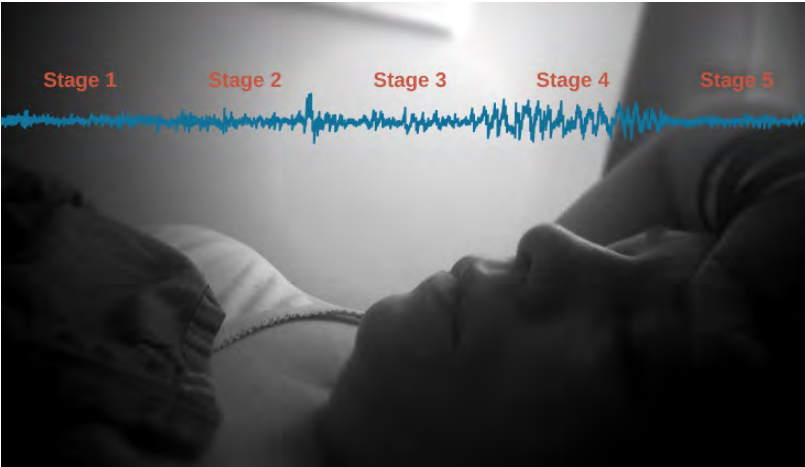
“Psychology: Chapter 4: States of Consciousness by OpenStax. Retrieved from https://learn.saylor.org/pluginfile.php/40708/mod_resource/content/1/OpenStax-Psychology.pdf. Licensed under CC-BY.
“Introduction to Psychology: Chapter 5, Section 1: Sleeping and Dreaming Revitalize Us for Action” by the University of Minnesota. Retrieved from http://open.lib.umn.edu/intropsyc/chapter/5-1-sleeping-and-dreaming-revitalize-us-for-action/. Licensed under CC BY-NC-SA.
Sleep
The Sleep Cycle
Sleep is not a uniform state of being. Instead, sleep is composed of several different stages that can be differentiated from one another by the patterns of brain wave activity that occur during each stage. These changes in brain wave activity can be visualized using EEG and are distinguished from one another by both the frequency and amplitude of brain waves. Sleep can be divided into two different general phases: REM sleep and non-REM (NREM) sleep.
Rapid eye movement (REM) sleep is characterized by darting movements of the eyes under closed eyelids. Brain waves during REM sleep appear very similar to brain waves during wakefulness. In contrast, non-REM (NREM) sleep is subdivided into four stages distinguished from each other and from wakefulness by characteristic patterns of brain waves. The first four stages of sleep are NREM sleep, whereas the fifth, and final, stage of sleep is REM sleep. Here, we will discuss each of these stages of sleep and their associated patterns of brain wave activity.
“Psychology: Chapter 4: States of Consciousness by OpenStax. Retrieved from https://learn.saylor.org/pluginfile.php/40708/mod_resource/content/1/OpenStax-Psychology.pdf. Licensed under CC BY.
Non-Rapid Eye Movement (non-REM) Sleep
The first stage of NREM sleep is known as stage 1 sleep. Stage 1 sleep is a transitional phase that occurs between wakefulness and sleep, the period during which we drift off to sleep. During this time, there is a slowdown in both the rates of respiration and heartbeat. In addition, stage 1 sleep involves a marked decrease in both overall muscle tension and core body temperature.
In terms of brain wave activity, stage 1 sleep is associated with both alpha and theta waves. The early portion of stage 1 sleep produces alpha waves, which are relatively low frequency (8–13Hz), high amplitude patterns of electrical activity (waves) that become synchronized. This pattern of brain wave activity resembles that of someone who is very relaxed, yet awake. As an individual continues through stage 1 sleep, there is an increase in theta wave activity. Theta waves are even lower frequency (4–7 Hz), higher amplitude brain waves than alpha waves. It is relatively easy to wake someone from stage 1 sleep; in fact, people often report that they have not been asleep if they are awoken during stage 1 sleep.
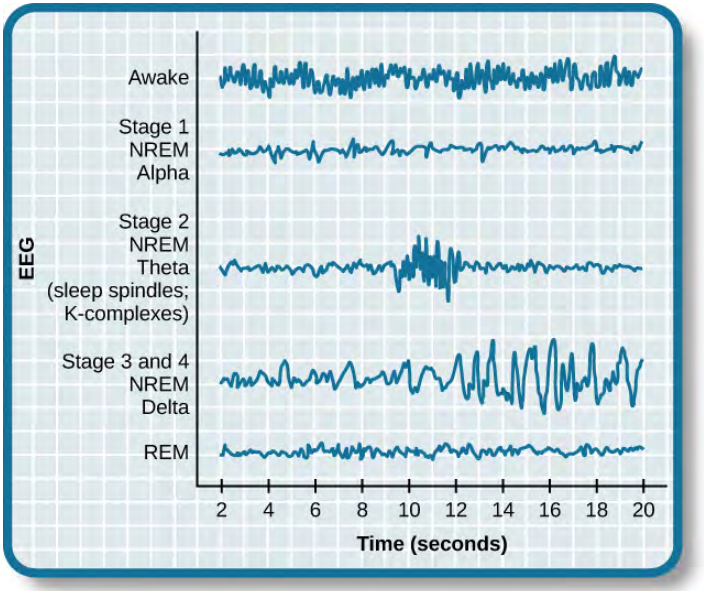
“Psychology: Chapter 4: States of Consciousness by OpenStax. Retrieved fromhttps://learn.saylor.org/pluginfile.php/40708/mod_resource/content/1/OpenStax-Psychology.pdf. Licensed under CC-BY.
As we move into stage 2 sleep, the body goes into a state of deep relaxation. Theta waves still dominate the activity of the brain, but they are interrupted by brief bursts of activity known as sleep spindles. A sleep spindle is a rapid burst of higher frequency brain waves that may be important for learning and memory (Fogel & Smith, 2011; Poe, Walsh, & Bjorness, 2010). In addition, the appearance of K-complexes is often associated with stage 2 sleep. A K-complex is a very high amplitude pattern of brain activity that may in some cases occur in response to environmental stimuli. Thus, K-complexes might serve as a bridge to higher levels of arousal in response to what is going on in our environments (Halász, 1993; Steriade & Amzica, 1998).
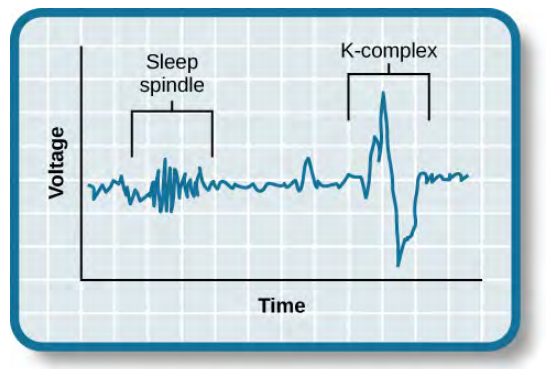
“Psychology: Chapter 4: States of Consciousness by OpenStax. Retrieved fromhttps://learn.saylor.org/pluginfile.php/40708/mod_resource/content/1/OpenStax-Psychology.pdf. Licensed under CC-BY.
Stage 3 and stage 4 of sleep are often referred to as deep sleep or slow-wave sleep because these stages are characterized by low frequency (up to 4 Hz), high amplitude delta waves. During this time, an individual’s heart rate and respiration slow dramatically. It is much more difficult to awaken someone from sleep during stage 3 and stage 4 than during earlier stages.
Interestingly, individuals who have increased levels of alpha brain wave activity (more often associated with wakefulness and transition into stage 1 sleep) during stage 3 and stage 4 often report that they do not feel refreshed upon waking, regardless of how long they slept (Stone, Taylor, McCrae, Kalsekar, & Lichstein, 2008).
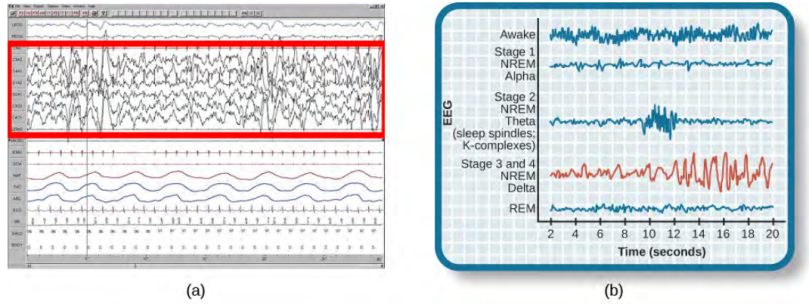
“Psychology: Chapter 4: States of Consciousness by OpenStax. Retrieved fromhttps://learn.saylor.org/pluginfile.php/40708/mod_resource/content/1/OpenStax-Psychology.pdf. Licensed under CC-BY.
“Psychology: Chapter 4: States of Consciousness by OpenStax. Retrieved from https://learn.saylor.org/pluginfile.php/40708/mod_resource/content/1/OpenStax-Psychology.pdf. Licensed under CC BY.
Rapid Eye Movement (REM) Sleep
As mentioned earlier, REM sleep is marked by rapid movements of the eyes. The brain waves associated with this stage of sleep are very similar to those observed when a person is awake, and this is the period of sleep in which dreaming occurs. It is also associated with paralysis of muscle systems in the body with the exception of those that make circulation and respiration possible. Therefore, no movement of voluntary muscles occurs during REM sleep in a normal individual.
REM sleep is often referred to as paradoxical sleep because of this combination of high brain activity and lack of muscle tone. Like NREM sleep, REM has been implicated in various aspects of learning and memory (Wagner, Gais, & Born, 2001), although there is disagreement within the scientific community about how important both NREM and REM sleep are for normal learning and memory (Siegel, 2001).
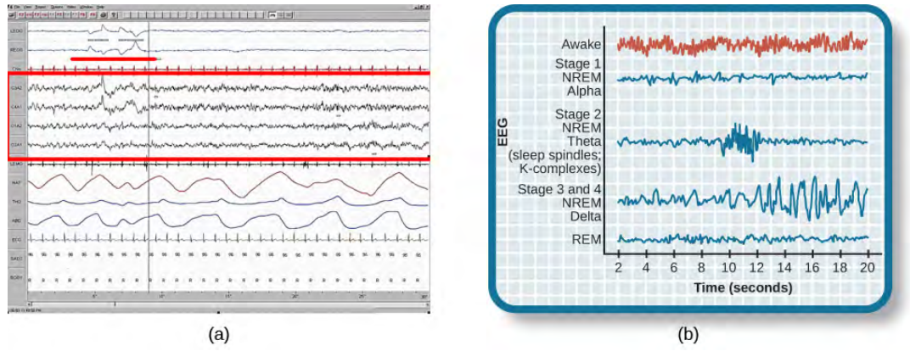
“Psychology: Chapter 4: States of Consciousness by OpenStax. Retrieved fromhttps://learn.saylor.org/pluginfile.php/40708/mod_resource/content/1/OpenStax-Psychology.pdf. Licensed under CC BY.
If people are deprived of REM sleep and then allowed to sleep without disturbance, they will spend more time in REM sleep in what would appear to be an effort to recoup the lost time in REM. This phenomenon is known as the REM rebound, and it suggests that REM sleep is also homeostatically regulated. Aside from the role that REM sleep may play in processes related to learning and memory, REM sleep may also be involved in emotional processing and regulation. In such instances, REM rebound may actually represent an adaptive response to stress in nondepressed individuals by suppressing the emotional salience of aversive events that occurred in wakefulness (Suchecki, Tiba, & Machado, 2012).
Although sleep deprivation in general is associated with a number of negative consequences (Brown, 2012), the consequences of REM deprivation appear to be less profound (as discussed in Siegel, 2001). In fact, some have suggested that REM deprivation can actually be beneficial in some circumstances. For instance, REM sleep deprivation has been demonstrated to improve symptoms of people suffering from major depression, and many effective antidepressant medications suppress REM sleep (Riemann, Berger, & Volderholzer, 2001; Vogel, 1975).
It should be pointed out that some reviews of the literature challenge this finding, suggesting that sleep deprivation that is not limited to REM sleep is just as effective or more effective at alleviating depressive symptoms among some patients suffering from depression. In either case, why sleep deprivation improves the mood of some patients is not entirely understood (Giedke & Schwärzler, 2002). Recently, however, some have suggested that sleep deprivation might change emotional processing so that various stimuli are more likely to be perceived as positive in nature (Gujar, Yoo, Hu, & Walker, 2011).
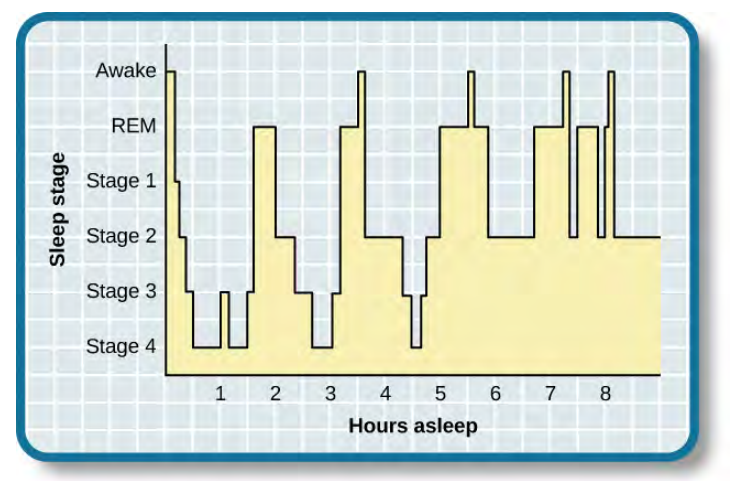
“Psychology: Chapter 4: States of Consciousness by OpenStax. Retrieved fromhttps://learn.saylor.org/pluginfile.php/40708/mod_resource/content/1/OpenStax-Psychology.pdf. Licensed under CC-BY.
Normally, we will go through several cycles of REM and non-REM sleep each night. The length of the REM portion of the cycle tends to increase through the night, from about 5 to 10 minutes early in the night to 15 to 20 minutes shortly before awakening in the morning. Dreams also tend to become more elaborate and vivid as the night goes on. Eventually, as the sleep cycle finishes, the brain resumes its faster alpha and beta waves and we awake, normally refreshed.
“Introduction to Psychology: Chapter 5, Section 1: Sleeping and Dreaming Revitalize Us for Action” by the University of Minnesota Retrieved from http://open.lib.umn.edu/intropsyc/chapter/5-1-sleeping-and-dreaming-revitalize-us-for-action/ Licensed under CC BY-NC-SA.
“Psychology: Chapter 4: States of Consciousness by OpenStax https://learn.saylor.org/pluginfile.php/40708/mod_resource/content/1/OpenStax-Psychology.pdf Licensed under CC BY.
Why Do We Sleep?
We spend approximately one-third of our lives sleeping. Given the average life expectancy for U.S. citizens falls between 73 and 79 years old (Singh & Siahpush, 2006), we can expect to spend approximately 25 years of our lives sleeping. Some animals never sleep (e.g., several fish and amphibian species); other animals can go extended periods of time without sleep and without apparent negative consequences (e.g., dolphins); yet some animals (e.g., rats) die after two weeks of sleep deprivation (Siegel, 2008).
Why do we devote so much time to sleeping? Is it absolutely essential that we sleep?
Given the central role that sleep plays in our lives and the number of adverse consequences that have been associated with sleep deprivation, one would think that we would have a clear understanding of why it is that we sleep. Unfortunately, this is not the case; however, several hypotheses have been proposed to explain the function of sleep.
“Psychology: Chapter 4: States of Consciousness by OpenStax. Retrieved from https://learn.saylor.org/pluginfile.php/40708/mod_resource/content/1/OpenStax-Psychology.pdf. Licensed under CC-BY.
Sleep Supports Adaptive Functioning
One popular hypothesis of sleep incorporates the perspective of evolutionary psychology. Evolutionary psychology is a discipline that studies how universal patterns of behavior and cognitive processes have evolved over time as a result of natural selection. Variations and adaptations in cognition and behavior make individuals more or less successful in reproducing and passing their genes to their offspring.
One hypothesis from this perspective might argue that sleep is essential to restore resources that are expended during the day. Just as bears hibernate in the winter when resources are scarce, perhaps people sleep at night to reduce their energy expenditures. While this is an intuitive explanation of sleep, there is little research that supports this explanation. In fact, it has been suggested that there is no reason to think that energetic demands could not be addressed with periods of rest and inactivity (Frank, 2006; Rial et al., 2007), and some research has actually found a negative correlation between energetic demands and the amount of time spent sleeping (Capellini, Barton, McNamara, Preston, & Nunn, 2008).
Another evolutionary hypothesis of sleep holds that our sleep patterns evolved as an adaptive response to predatory risks, which increase in darkness. Thus, we sleep in safe areas to reduce the chance of harm. Again, this is an intuitive and appealing explanation for why we sleep. Perhaps our ancestors spent extended periods of time asleep to reduce attention to themselves from potential predators. Comparative research indicates, however, that the relationship that exists between predatory risk and sleep is very complex and equivocal. Some research suggests that species that face higher predatory risks sleep fewer hours than other species (Capellini et al., 2008), while other researchers suggest there is no relationship between the amount of time a given species spends in deep sleep and its predation risk (Lesku, Roth, Amlaner, & Lima, 2006).
It is quite possible that sleep serves no single universally adaptive function, and different species have evolved different patterns of sleep in response to their unique evolutionary pressures. While we have discussed the negative outcomes associated with sleep deprivation, it should be pointed out that there are many benefits that are associated with adequate amounts of sleep. A few such benefits listed by the National Sleep Foundation (n.d.) include maintaining healthy weight, lowering stress levels, improving mood, and increasing motor coordination, as well as a number of benefits related to cognition and memory formation.
“Psychology: Chapter 4: States of Consciousness by OpenStax. Retrieved from https://learn.saylor.org/pluginfile.php/40708/mod_resource/content/1/OpenStax-Psychology.pdf. Licensed under CC-BY.
Sleep Supports Cognitive Functioning
Another theory regarding why we sleep involves sleep’s importance for cognitive function and memory formation (Rattenborg, Lesku, Martinez-Gonzalez, & Lima, 2007). Indeed, we know sleep deprivation results in disruptions in cognition and memory deficits (Brown, 2012), leading to impairments in our abilities to maintain attention, make decisions, and recall long-term memories. Moreover, these impairments become more severe as the amount of sleep deprivation increases (Alhola & Polo-Kantola, 2007).
Furthermore, slow-wave sleep after learning a new task can improve resultant performance on that task (Huber, Ghilardi, Massimini, & Tononi, 2004) and seems essential for effective memory formation (Stickgold, 2005). Understanding the impact of sleep on cognitive function should help you understand that cramming all night for a test may be not effective and can even prove counterproductive.
Sleep has also been associated with other cognitive benefits. Research indicates that included among these possible benefits are increased capacities for creative thinking (Cai, Mednick, Harrison, Kanady, & Mednick, 2009; Wagner, Gais, Haider, Verleger, & Born, 2004), language learning (Fenn, Nusbaum, & Margoliash, 2003; Gómez, Bootzin, & Nadel, 2006), and inferential judgments (Ellenbogen, Hu, Payne, Titone, & Walker, 2007). It is possible that even the processing of emotional information is influenced by certain aspects of sleep (Walker, 2009).
“Psychology: Chapter 4: States of Consciousness by OpenStax. Retrieved from https://learn.saylor.org/pluginfile.php/40708/mod_resource/content/1/OpenStax-Psychology.pdf. Licensed under CC-BY.
Dreams
Dreams are the succession of images, thoughts, sounds, and emotions that passes through our minds while sleeping. When people are awakened from REM sleep, they normally report that they have been dreaming, suggesting that people normally dream several times a night but that most dreams are forgotten on awakening (Dement, 1997). The content of our dreams generally relates to our everyday experiences and concerns, and frequently our fears and failures (Cartwright, Agargun, Kirkby, & Friedman, 2006; Domhoff, Meyer-Gomes, & Schredl, 2005).
Many cultures regard dreams as having great significance for the dreamer, either by revealing something important about the dreamer’s present circumstances or predicting his future. The Austrian psychologist Sigmund Freud (1913/1988) analyzed the dreams of his patients to help him understand their unconscious needs and desires, and psychotherapists still make use of this technique today. Freud believed that the primary function of dreams was wish fulfillment, or the idea that dreaming allows us to act out the desires that we must repress during the day.
Freud differentiated between the manifest content of the dream (i.e., its literal actions) and its latent content (i.e., the hidden psychological meaning of the dream). Freud believed that the real meaning of dreams is often suppressed by the unconscious mind in order to protect the individual from thoughts and feelings that are hard to cope with. By uncovering the real meaning of dreams through psychoanalysis, Freud believed that people could better understand their problems and resolve the issues that create difficulties in their lives.
Although Freud and others have focused on the meaning of dreams, other theories about the causes of dreams are less concerned with their content. One possibility is that we dream primarily to help with consolidation, or the moving of information into long-term memory (Alvarenga et al., 2008; Zhang (2004). Rauchs, Desgranges, Foret, and Eustache (2005) found that rats that had been deprived of REM sleep after learning a new task were less able to perform the task again later than were rats that had been allowed to dream, and these differences were greater on tasks that involved learning unusual information or developing new behaviors. Payne and Nadel (2004) argued that the content of dreams is the result of consolidation—we dream about the things that are being moved into long-term memory. Thus dreaming may be an important part of the learning that we do while sleeping (Hobson, Pace-Schott, and Stickgold, 2000).
The activation-synthesis theory of dreaming (Hobson & McCarley, 1977; Hobson, 2004) proposes still another explanation for dreaming—namely, that dreams are our brain’s interpretation of the random firing of neurons in the brain stem. According to this approach, the signals from the brain stem are sent to the cortex, just as they are when we are awake, but because the pathways from the cortex to skeletal muscles are disconnected during REM sleep, the cortex does not know how to interpret the signals. As a result, the cortex strings the messages together into the coherent stories we experience as dreams.
Although researchers are still trying to determine the exact causes of dreaming, one thing remains clear—we need to dream. If we are deprived of REM sleep, we quickly become less able to engage in the important tasks of everyday life, until we are finally able to dream again.
“Introduction to Psychology: Chapter 5, Section 1: Sleeping and Dreaming Revitalize Us for Action” by the University of Minnesota. Retrieved from http://open.lib.umn.edu/intropsyc/chapter/5-1-sleeping-and-dreaming-revitalize-us-for-action/ Licensed under CC BY-NC-SA.
Sleep – Video
CrashCourse. (2014, March 31). To sleep, perchance to dream – Crash Course Psychology #9. [Video File]. Retrieved from https://www.youtube.com/watch?v=rMHus-0wFSo&index=9&list=PL8dPuuaLjXtOPRKzVLY0jJY-uHOH9KVU6. Standard YouTube License.
SciShow. (2013, October 14). Sleep: Why we need it and what happens without it. [Video File]. Retrieved from https://www.youtube.com/watch?v=pwNMvUXTgDY. Standard YouTube License.
Summary
We devote a very large portion of time to sleep, and our brains have complex systems that control various aspects of sleep. Several hormones important for physical growth and maturation are secreted during sleep. Although the reason we sleep remains something of a mystery, there is some evidence to suggest that sleep is very important to learning and memory.
Sleep, an essential state of natural rest, is observed in most animals. It is characterized by reduced voluntary body movement, decreased reaction to external stimuli, and a loss of consciousness. Sleep consists of two major stages: REM and non-REM sleep. Non-REM sleep has three substages, known as stage N1, N2, and N3. Each sleep stage is marked by a specific pattern of biological responses and brain wave patterns.
Humans sleep an average of 7.5 hours, during which they proceed in around 100 minute cycles of two broad types. Rapid eye movement (REM) occupies roughly 25% of sleep time. During this stage the body shows a loss of skeletal muscle tone while the brain is quite active. Electroencephalography (EEG) shows a mixture of frequencies that is similar in appearance to the wakeful EEG and coincides with periods of intense dreaming. Non-rapid eye movement (NREM) sleep occupies most of the sleep time and is characterized by frequent limb movements and sleep walking while the brain exhibits reduced activity and little dreaming.
The different stages of sleep are characterized by the patterns of brain waves associated with each stage. As a person transitions from being awake to falling asleep, alpha waves are replaced by theta waves. Sleep spindles and K-complexes emerge in stage 2 sleep. Stage 3 and stage 4 are described as slow-wave sleep that is marked by a predominance of delta waves. REM sleep involves rapid movements of the eyes, paralysis of voluntary muscles, and dreaming. Both NREM and REM sleep appear to play important roles in learning and memory.
The inherent function of sleep is not yet completely understood. Sleep, which affects the immune system and metabolism, supports a restorative function with increases in wound healing and the production of anabolic growth hormones. Sleep is marked by a variety of physiological processes of growth and rejuvenation of the organism’s immune, nervous, muscular, and skeletal systems. In newborns, sleep appears to play a critical role in establishing proper functional connectivity in the brain.
A number of studies suggest the existence of a correlation between sleep and the many complex functions of memory. Memory and learning involve nerve cell dendrites sending information to the cell body to be organized into new neuronal connections. Sleep, which reprocesses the day’s events in the absence of external information, is processed by these dendrites as memories are solidified and knowledge is organized (Saper and Stickgold 2005).
Dreams may represent life events that are important to the dreamer. Alternatively, dreaming may represent a state of protoconsciousness, or a virtual reality, in the mind that helps a person during consciousness. Dreams occur primarily during REM sleep. Some theories of dreaming, such Freud’s, are based on the content of the dreams. Other theories of dreaming propose that dreaming is related to memory consolidation. The activation-synthesis theory of dreaming is based only on neural activity.
“Animal Behavior: Chapter 3, Section 5: Biological Rhythms” by Wikibooks. Retrieved from https://en.wikibooks.org/wiki/Animal_Behavior/Biological_Rhythms. Licensed under CC-BY-SA.
Assessment Questions: “Psychology: Chapter 4: States of Consciousness by OpenStax. Retrieved from https://learn.saylor.org/pluginfile.php/40708/mod_resource/content/1/OpenStax-Psychology.pdf. Licensed under CC-BY.
“Introduction to Psychology: Chapter 5, Section 1: Sleeping and Dreaming Revitalize Us for Action” by the University of Minnesota. Retrieved from http://open.lib.umn.edu/intropsyc/chapter/5-1-sleeping-and-dreaming-revitalize-us-for-action/. Licensed under CC BY-NC-SA.
“Psychology: Chapter 4: States of Consciousness by OpenStax. Retrieved from https://learn.saylor.org/pluginfile.php/40708/mod_resource/content/1/OpenStax-Psychology.pdf. Licensed under CC-BY.